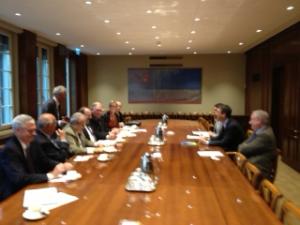“The World Trade Organization needs to be part of the solution on biotechnology trade disruptions,” said MAIZALL President and U.S. Grains Council Past Chairman Julius Schaaf. “To feed 9 billion people by 2050, and do it in the face of growing land, water and environmental constraints, producers need technology.
“But to keep advancing technology, we also need regulatory systems capable of proceeding in a timely, transparent and science based way. That’s why we’re here – to urge the WTO to be more engaged on asynchronous biotech approvals and their effects on global trade.”
Schaaf was speaking from Geneva, where MAIZALL met with WTO Director General Roberto Azevedo and other senior WTO officials. With representatives from the Council, National Corn Growers Association, Abramhilo (Brazil) and Maizar (Argentina), MAIZALL presents a united front from the three major corn exporting countries of the Americas, which together account for more than 70 percent of the world’s exportable corn surplus.
“In the previous MAIZALL missions, including to China and the EU, it became clear that many people do not yet realize that biotech is a matter of common concern to all the MAIZALL countries,” said USGC Chairman Ron Gray. “We have had some very useful conversations on strategies to elevate issues such as asynchronous approvals and low level presence to greater visibility in the WTO community. Having Argentina and Brazil at the table with the United States clearly has a beneficial impact.”
The team’s next stop will be in Rome to meet with the Food and Agriculture Organization (FAO). Continuing advances in agricultural technology, including biotechnology, are clearly needed to achieve FAO’s goal of global food security. A point of particular importance to the FAO is that biotechnology is a scale-neutral technology that offers benefits to small as well as large producers. It is accessible to small farmers in the developing world and can further important rural development objectives.


